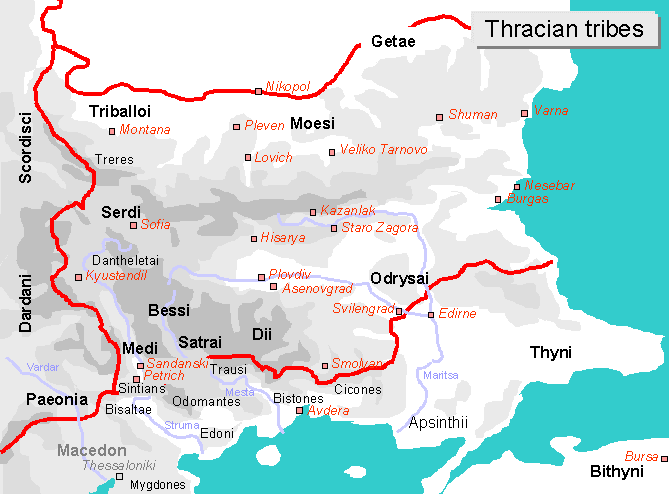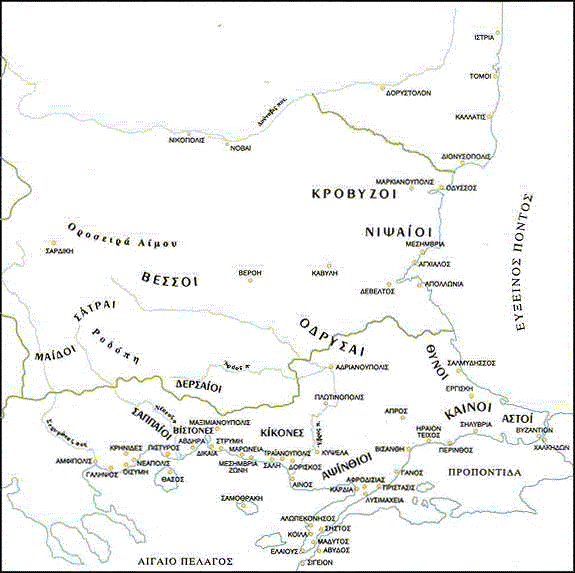Agriai
Αγριάνες / Αγρίαι. |
The
Agriai lived on the high barren Σκόμιον and on the north-east Rodope
mountains. They grew cattle and fought as mercenaries to the Odrysae,
the Athenians and the Romans |
Apsinthioi
Αψίνθιοι |
From
the mouth of the river Ebros to the north of the
Thracian Chersonese, the peninsula with the town of Galipoli, now in
Turkey. They are known to have raided the Greek towns on the Chersonese. |
Ardiaioi
Αρδιαίοι |
Living
to the north-east of the Agriai. |
Astai
Ασται |
A
warlike tribe of robbers in the city of Βιζύη. |
Bessoi
Βήσσοι / Βέσσοι |
The
Bessoi belonged to the tribe of Satrai.
They inhabited the mountain regions on
the upper course of the river Mesta (Nestos / Νέστος) to the north of
the Odrasae. They invented the technique of undermining enemy
fortifications either entering the cities throught eh tunnels or
causing the city the walls to collapse. The Bessoi are
known to have continued to speak their own language in 570 AD. |
Bisaltai
Βισάλται |
Settling
in the valey of the river Στρυμών and extending to the north of
Amphipolis and to Herakleia Sintika. They were possibly a Pelasgian
people. |
Bithynoi
Βιθυνοί / Θύνοι |
By
the 5th century BC
the Bithynοi were practically independent from Persia. The Bithynian
chief, called Doedalsus, unified the Thracians in north west Asia Minor
and founded the Bithynian kingdom. In the 4th century BC the region
came under Alexander's general Antigonus followed by Lysimachus,
followed by the Bithynians retaking the region. Nicea and Nicomedia
(now Iznik and Izmit in Turkey) were the main towns, with Prusa (Bursa)
being founded by king Prusias I. The Bithynians remained mostly
independent until 75 BC when the kingdom was bequeathed to Rome by
Prusias’ grandson. The names of the Thracian tribes continued through
to the Roman provinces of Blythia and Mysia. |
Bistones
Βίστονες |
A
district in southern Thrace on the coast to the east of Abdera. Biston
was the son of Κίκων in Greek mythology. The
lake Βιστονίς has been named after them. Diomedes was famous in
Mythology for being himself and his people wild and bloodhtursty. He
bred horses so untamed that they would bite to death anyone they were
not familiar with. Herakles faught and killed Diomedes, and founded the
cioty of Abdera around his tomb in honour of his companion Αβδηρος who
was killed by Diomedes' horses. |
Brenai
Βρέναι
|
A
tribe of robbers north of the Korpiloi |
Brygoi, Bryges, Phryges
Βρύγoi, Βρίγες |
An
ancient Thracian tribe from mount Βέρμιον in Macedonia. They moved to
Anatolia in the 12th century BC to become the Phrygians. A group stayed
on the Greek mainland east of the Κεραυνίων mountains where they stayed
into the historical times. |
Dakians / Dacae
Δακοί / Δάκες / Δάοι |
The
Dacians lived in the Carpathian Mountains in present Transylvania. They
were linguistically closely related he Getae inhabiting
the lands southeast of them along the banks of the lower Danube.
They appeared in the 2nd century BC and made close connections with the
Romans. This “late” appearing on the Balkan Peninsula does mean that
they were new people. They were unified not before the 1st century BC,
in the large but short-lived state of their king Burebista. In the 3rd
and 4th century they underwent the invasion of the Goths and Scythians
who finally occupied their lands. |
Dantheletai
Δενθαλήται / Δενθελήται / Δενθηλάται. |
The
Dantheletai lived mainly in the northernmost part of the Strymon in
Macedonia to the north of the Sapaians and to the south of the Serdoi. |
Dardanoi
Δαρδάνιοι / Δάρδανοι |
The
tribe living to the northern and western most regions of the Thracians,
of Thraco-Pelasgonian origin. |
Digeroi
Δίγηροι |
On
the left side of the Strymon river between the Dantheletai
and the
Bessoi. |
Dioi
Δίοι οι Μαχαιροφόροι |
Thucydides
of Greece said that the Dioi of the Rodope mountains were the most
warlike troops among the infantry. |
| Δόβηρες |
A
warlike tribe settling to the south of Paeonia. |
Dologoi
Δόλογκοι |
A
peaceful people of the Thracian Chersonese, who profited from the
culture of the Greek colonies. |
Dersaioi
Δερσαίοι / Δερραίοι |
A
small warlike tribe living on the northern mountains to the west of the
river Strymon. |
Drooi
Δρώοι |
A
small warlike tribe living on the northern mountains to the west of the
river Strymon. |
Edonioi
Ηδωνοί / Ηδωνες / Ωδονες |
Around
Mount Pangaeus (Παγγαίον). One part of these Thracians were known
by the Greeks as the Panaioi. Pan probably comes from
the Thracian word *pan(s)- meaning a swamp or bog. |
Getae
Γέται |
The
Getae lived between the Balkan mountains in the south, neighbouring the
Scythians to the east, and the Moesoi to the west, approximately the
area of Dobrogea/Dobrudza and Romanian Muntenia. The Romanians place
them as early Dacians, the Bulgarians claim them to be Thracian, but as
all the Danubian tribes were probably related both views may be true.
The Greek Herodotus mentions a royal marriage between the Getae and
Scythians. |
Kainoi
Καίνοι
|
To
the north and east of the Korpiloi and the Apsinthioi
a few miles from the city of Kypsela (Κύπσελα). |
Kikones / Cicones
Κίκονες |
The
Kikones were a tribe of highly developed culture
in the region between the Biston lake and the lower course of the Ebros
(Εβρος / Maritsa) river. |
Koilaletai
Κοιλαλήται |
Little
known Thracian tribe between the mountains Aimos and Rodope. |
Koralloi
Κορέλλοι / Κόραλλοι |
Robbers,
neighbours of the Kainoi. |
Korpiloi
Κόρπιλοι |
North
of the Paitoi along the navigable portion of the Ebros river, A tribe
of robers |
Krobyzoi
Κρόβυζοι / Κρύβυζοι |
To
the north-east of Mount Aimos along the river Istros to the coast of
the Black Sea. |
Maidoi / Medoi / Maedoi
Μαίδοι
|
Neighbours
of the Odomantes to the north in
the mountainous region in Pirin Bulgaria along the Struma (Στρυμών,
Στρυμόνας) valley river. Their towns are now called Sandanski and
Petrich. |
Moesoi
Μοίσοι / Μυσοί |
The
Moesians (Mysians) ruled the lands between the Danube and Balkan
mountains (Stara Planina), and possibly also north of the Danube. The
Romans defeated them in the first century BC, and by 28 BC their name
was given to the extensive Roman province which included all the lands
south of the Danube from the Black Sea to the Sava. Under the pressure
of invading Getae and Scyths Mysians also moved to Asia Minor living
among
the Lydians, Phrygians and Trojans. The names of the
Thracian tribes in Asia Minor continued through to the Roman provinces
of Blythia and Mysia. |
Mygdones
Μύγδονες και Σίθωνες |
Pierians
who settled in the region of Mygdonia or Mygdn, between
the rivers Αξιός and Στρυμόνας, to the north of lake Βόλβη, in the 7th
century BC. The peninsula of Σιθωνία in Chalkidike was
named after their settlement. |
Odomantes
Οδομάντες |
Neighbors of the Bisaltai on the coast to the east of the river Στρυμών.
They have been involved in metal mining. |
Odrysae /Odrisoi / Odrisai
Οδρύσαι |
The
Odrysae were the most powerful Thracian tribe
since the 5th century BC. They were based in the central Thracian plain
with towns at, or near, the modern towns of Plovdiv, Asenovgrad,
Kazanlak, and Stara Zagora, however their empire extended from the
Black Sea coast along along the Agean coast to Abdera (now Αβδηρα in
Greece) and included the town of Uscudama (now Edirne in Turkey). The
Odrysae were the nucleus of the Thracian kingdoms founded by Teres I
(Τήρης Α') and grown to prosperity under his on Sitalkes (Σιτάλκης). |
Orreskioi
Ορρέσκιοι |
Possibly
identical to the Satrai. |
Paitoi
Παίτοι |
A
small tribe of little importance at around the mouth of the Ebros river. |
Panaioi
Παναίοι |
A
small warlike tribe living on the northern mountains to the west of the
river Strymon. |
Paeones
Παίονες
|
Paeonia
is now in the Republic of Macedonia, north of ancient Macedonia
where the Vardar (Βαρδάρης, Αξιός) river goes through narrows, west of
the Thracians of the Struma (Στρυμών
/ Στυμόνας)
valley. The Paeonians are documented by Herodotus, then five centuries
later by Strabo, then two centuries later Dio Cassius places the
Paeonians in a larger area up to and along the Danube. Paenia united
many different Thracian tribes, the Παίονες, Σιροπαίονες, Γρααίοι,
Λαιαίοι, Παιόπλαι and Παναίοι. They were a warlike people and ravaged
the country of their neighbours and of Macedonia. They were subdued by
the Macedonian Philip II. |
Pieres
Πίερες |
A
cultured people with a love for music and poetry. Originaly from the
region north of mount Olympos, they were driven away by the Temenidai
from Argos in the 7th century BC and
settled at the feet of mount Παγγαίον. The Pierian gulf at the coast
was named after them. Some of these thracians also settled in the lands
between the rivers Αξιός and Στρυμόνας in Mygdonia. |
Phrygians
Φρύγες |
Probably
also known as the Brygoi, Bryges, Phryges and Brigians. They
are thought to have moved in to west and central Anatolia from Thrace
around 1200 BC. Their language is thought to be linked to modern
Armenian. Herodotus records an account that the Phrygians once lived in
Macedonia and were removed to Asia Minor. |
Sapaioi
Σαπαίοι / Σιντοί |
In
prehistoric times the inhabitants of the region of Abdera (Αβδηρα) and
the island of Samothrace (Σαμοθράκη) originally called Σίντιες. One of
the largest Thracian races employed in metal mining before the 8th
century BC. This they learned from the Thasians, which later they drove
out of their countries. The war of the Macedonian king Perseus against
the Sapaians was the cause for the Romans to do away with the
Macedonian kingdom.
|
Satrai
Σάτραι / Σατροκένται |
The
tribe of Satrai lived in
the moutains between the Mesta (Νέστος) and Struma (Στρυμών
/ Στυμόνας) rivers. |
| Serdoi |
Serdica
(now Sofia) was named after the Serdi Thracian tribe. |
| Sintians |
The
Sintians were located between the Paeonians and Maedi. |
Skyrmiadai
Σκυρμιάδαι |
On
the southern foot of mount Aimos at the coast of the Black Sea
(Εύξεινος Πόντος). |
| Scordiscoi |
The
Scordiscoi are thought to have been a Celtic
tribe, possibly assimilated with Illyrians and Thracians, that lived
where the river Sava meets the Danube, around Belgrad in modern Serbia. |
Tralleis
Τράλλεις |
A
warlike Thracian tribe. |
Trausoi
Τραύσοι |
North-east
region of the Rodope mountains. |
| Thynoi |
The
Thynoi lived in south eastern Thrace and their terror reportedly
prevented Greek settlement in that area. |
Triballoi
Τριβαλλοί |
The
Triballoi lived
between the Morava and the Danube, their rule extending across the
plains of north western Bulgaria. They rose cattle and were mercenaries
for a living. Their history ends after Alexander's
death and the invasion of Celtic tribes. The memory of the Triballοi as
a once great and powerful tribe continued, even being applied to the
later Serb peoples. |
Troglodytai
Τρωγλοδύται |
Neighbours to the north-east of the
Krobyzoi. |
Treres
Τρήρες / Τιλαταίοι
|
The Treres were
neighbours of the Triballoi living to the north of Mount Σκόμιον.
|


